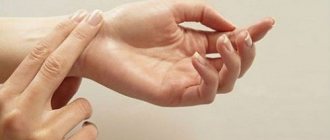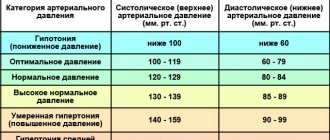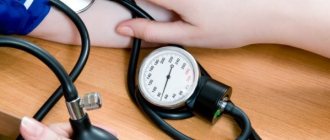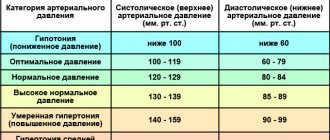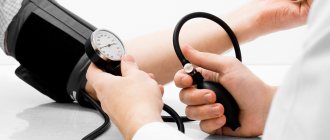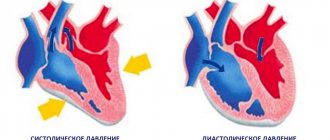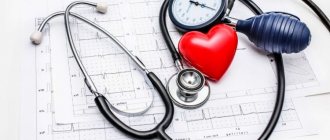Blood pressure (BP) is considered the most unstable indicator of the human body. Its level can change a huge number of times throughout the day at any age. This is due to hormonal levels, changes in weather conditions, emotional state, physical activity, etc. The average blood pressure is considered to be 120/80 mm Hg. Art. The numbers increase and decrease, the reasons for which may be physiological and pathological factors.
In this article we will talk about pressure readings of 100 to 60. What does this mean, should adults, children and women be wary of such numbers during pregnancy, and also what to do if the reasons for the appearance of such numbers on the tonometer are pathological processes in the human body.
What does each number mean?
Blood pressure is a measure of the pressure that blood exerts on the walls of blood vessels as it passes through them. The blood flow is created by the heart, which works like a pump. The heart muscle has the ability to contract (systole) and relax (diastole). During the first period, blood is pushed into large arteries, which is accompanied by the highest pressure levels. This is the first number. In this case we are talking about 100. The indicator is called systolic or upper (in common parlance) pressure.
During relaxation, the second number is recorded (in this case, 60). It is also called diastolic pressure or lower. Experts pay attention not only to these numbers, but also calculate the difference between them, calling this indicator pulse pressure. The blood pressure level is formed under the influence of the following factors:
- The force with which the heart pushes blood into the vessels.
- Hormonal background.
- Conditions of the central and peripheral nervous system.
- Conditions and indicators of arterial elasticity.
- The total volume of blood circulating in the body.
Important! The normal blood pressure level is considered to be 120–129/80–84 mmHg. Art.
When is a blood pressure of 110 over 50 normal?
It would not be an exaggeration to say never. In extremely rare cases, such blood pressure may be a working option, but this is casuistry.
Because there is a serious difference between systolic and diastolic indicators. Diagnosis and appropriate treatment for this condition are required. It's dangerous.
Causes of hypotension
Biophysical factors that are involved in the development of hypotension are:
- Decreasing the amount of venous blood that returns to the heart.
- Decrease in total circulating blood volume.
- Reduced vascular resistance in the periphery.
- Decrease in cardiac output and stroke.
Pathologies of pregnant women
Blood pressure of 100 over 60 during pregnancy, especially in women over 30 years of age, is considered a pathology, especially if symptoms of hypotension are added. Most often, low blood pressure is observed at the end of the first trimester of pregnancy and at 19-23 weeks. Persistent hypotension can cause oxygen starvation of the fetus, which provokes the development of malnutrition and damage to the child’s central nervous system. It is important to monitor the blood pressure of a pregnant woman in order to have time to adjust the numbers.
Teenage years
Adolescents aged 12–13 years experience hormonal changes in the body, which may be accompanied by a decrease in blood pressure. Girls are more likely to face this problem than boys. Hypotension is combined with both accelerated physical development of the body and its slowdown.
Important! A persistent drop in blood pressure during puberty (adolescence) can trigger the development of severe hypertension at a later age.
Psychological characteristics and constitution
Experts say that low blood pressure (for example, 101 to 63, 104 to 64) is more often complained of by patients who are prone to depression and an exaggerated sense of duty. In such cases, treatment is largely aimed not at taking medications, but at using meditative techniques, yoga, breathing exercises, and herbal medicine.
If we talk about the relationship between arterial hypotension and body constitution, then people with an asthenic body type more often complain about a decrease in blood pressure. In such patients, longitudinal dimensions prevail over transverse ones: arms and legs are long, the neck is thin and long, and the muscles are poorly developed.
Lack of physical activity
Modern innovations in technology are causing people to stop moving. Most people prefer to work and relax while sitting at the computer. In this case, not only hypotension occurs, but also cardiovascular diseases, digestive pathologies, and diseases of the musculoskeletal system due to weakness of the muscular system and joints.
Chronic infections
A third of patients who go to doctors with complaints of low blood pressure, dizziness, periodic pulsation in the back of the head and frequent headaches have foci of chronic infection in the body. In this case, hypotension is caused by intoxication, metabolic disorders (metabolism), and circulatory disorders.
Endocrine diseases
The organs of the endocrine apparatus are responsible for the state of the body's hormonal levels. The most common causes of hypotension are Addison's disease (adrenal dysfunction, characterized by a decrease in the amount of hormones produced) and hypothyroidism (lack of thyroid hormones).
Medicines
Long-term or uncontrolled use of medications can serve as a factor in lowering blood pressure. We are talking about the following groups of drugs:
- Sleeping pills.
- Painkillers.
- Antibacterial agents.
- Tranquilizers.
- Sedatives.
- Diuretics, etc.
Features of the course in elderly people
In older people, low blood pressure is somewhat less common than high blood pressure. Diseases develop as a result of dysfunction of the heart muscle and brain, as a result of which tissues and organs lack oxygen and nutrients. This causes a decrease in the functional activity of the body as a whole, which negatively affects well-being.
An attack of hypotension in an elderly person can provoke serious complications, for example, hemodynamic disturbances lead to hypoxia of the brain, as a result of which the activity of its parts decreases. When the peripheral circulation is disturbed, cardiogenic shock occurs, and when arterial hemodynamics are disturbed, an ischemic stroke occurs.
Types of hypotonic conditions
Primary hypotension is characterized by a decrease in blood pressure, the causes of which are not pathologies of the heart and blood vessels. Secondary, on the contrary, is a manifestation of a disease. Depending on how long the numbers remain at low levels, acute and chronic forms of the pathological condition are distinguished. In the first case, if we talk about blood pressure 100/60, such numbers remain at a low level for a short time, in the second - over a long period.
Physiological form
We can talk about a physiological variant of hypotension if a pressure of 100/60 (or other low numbers) is discovered by chance, is not accompanied by a deterioration in general well-being and is caused by some physiological reason. Hypotension can be an individual variant of the norm, observed in people actively involved in sports and those living in tropical and subtropical climates.
Pathological form
This type of blood pressure reduction exists in two variations: neurocirculatory and idiopathic orthostatic. The first type manifests itself with a clear clinical picture, the second is characterized by a drop in blood pressure only if the body position changes from horizontal to vertical (for example, when getting out of bed in the morning).
Symptomatic form
She is secondary. It is a symptom of a certain disease. May occur against the background of:
Blood pressure 100 to 80
- Diseases of the heart and blood vessels (heart failure, cardiomyopathy, inflammation of the myocardium, pericardium).
- Pathologies of the respiratory system (pneumonia, tuberculosis, bronchial asthma).
- Diseases of the gastrointestinal tract (stomach and duodenal ulcers).
- Diseases of the renal apparatus (econephropathy, nephritis).
- Pathologies of the nervous system (Parkinson's disease, encephalopathy, cerebral infarction, mental illness).
If a woman is expecting a child
During pregnancy, a woman's blood pressure tends to increase, especially in the second half of the term.
At the same time, doctors pay attention: a pressure of 110/70 during pregnancy should not cause concern, because the physiological norm is from 110 to 70 to 140 to 90. But if the numbers on the tonometer are out of this range, then you should consult a doctor
Both hypotension and hypertension may develop.
It has been noted that in the initial stages a decrease in pressure may be observed. This is due to changes in hormonal levels in a woman’s body. By the way, monitoring blood pressure during pregnancy is one of the important factors for assessing her own health and the well-being of the unborn baby.
If you often have high or low blood pressure, then you need to purchase a tonometer. Blood pressure is the pressure of blood on the vascular walls. The pressure when blood is released into the circulatory system (upper) is systolic. During the pause period, between emissions (lower) – diastolic. The difference between these pressures is the pulse pressure.
Feeling good with blood pressure 100/60
If the pressure drops sharply, the patient complains of headache, dizziness, pulsation in the back of the head, rapid heartbeat (at a pressure of 100 to 60, the pulse can reach 100 beats/min). Cold sweat, severe weakness appear, trembling in the limbs may occur, and body temperature decreases. The result of a critical drop in indicators is a fainting state requiring emergency assistance.
With chronic hypotension, the patient complains of daily weakness, fatigue, emotional lability, depression, and shortness of breath. With a chronic type of pathology, people get used to attributing their poor health to all sorts of factors, but not to a drop in pressure. The problem is associated with changes in weather conditions, fatigue at work, stress, overeating or, conversely, diet abuse.
Characteristic signs
A decrease in blood pressure is accompanied by circulatory disorders, so the brain receives an insufficient amount of oxygen and nutrients, which affects overall well-being.
Patients experience memory loss and confusion
Among the main signs of the development of hypotension are:
- Headache radiating to the temporal and occipital region, which is permanent.
- Attacks of nausea during the period when the head hurts.
- Deterioration of condition when weather conditions change.
- Darkening of the eyes followed by dizziness and loss of consciousness.
- Muscle weakness, increased fatigue.
- Myocardial dysfunction, increased heart rate.
- Coldness of the extremities, numbness as a result of insufficient blood circulation.
As a rule, hypotensive people have an unstable nervous system, which is expressed in irritability and a tendency to depression.
Diagnostic measures
When contacting specialists with a problem of low blood pressure (for example, 100–106 to 60–66), patients are interested in the question of whether this is normal, and if not, how to improve the readings. The doctor must ask the patient about the following points:
- When were such pressure indicators first noticed?
- Associated symptoms.
- What is the patient’s “working” pressure?
- Do the patient and his relatives have any diseases of the cardiovascular system?
- The presence of pathologies of other systems.
- Does the person take any medications, etc.
Hypotension can cause fainting
Blood pressure must be measured several times at intervals of 5–10 minutes. If necessary, daily monitoring of blood pressure with monitoring of pulse and other indicators of heart function is prescribed. Additional methods include ECG, echocardiography, electro- and rheoencephalography, and examination by an ophthalmologist.
Foot bath
With hypotension, there is a decrease in vascular tone and a weakening of cardiac activity, and the lower extremities begin to freeze. This can trigger the development of heart disease in the future, so blood circulation should be normalized.
Regular use of contrasting foot baths has a good effect (the water temperature must be increased from +35 °C to +44 ℃ within 20 minutes).
Water procedures will help improve blood circulation in the vascular system and increase the resistance of blood vessels to blood pressure.
Correction of indicators and first aid
To increase the pressure, you must follow the following algorithm:
- Call a team of medical workers.
- Lie on a horizontal surface with the leg end raised or lay the victim down in this way.
- Open a window or direct a fan to provide fresh air.
- Drink sweet warm tea or give the victim something to drink. You can add 10 drops of tincture of eleutherococcus, ginseng or Rhodiola rosea.
- Rub your whiskey with lemon essential oil.
Folk remedies with a tonic effect
To increase blood pressure, you can also use folk remedies, some of which are available in every home. All of them have a tonic effect and can help with severe hypotension.
Folk remedies for increasing blood pressure:
- Coffee with sugar. Caffeine raises blood pressure quickly, but does not last very long. When combined with sugar, this drink will be more effective. It is worth noting that large amounts of coffee have a negative effect on heart health.
- Hot black or green tea. These drinks contain an analogue of caffeine, which increases blood pressure more slowly, but lasts longer. It is very important that such drinks are strong and hot enough. Iced green tea has the opposite effect.
- Aromatherapy can also help. For this you can use essential oils of cypress, nutmeg, ginger or rose.
- Dark chocolate or hot cocoa will also help normalize blood pressure readings. To enhance the effect, you can add a pinch of pepper to the cocoa.
Sweet and salty foods contribute to increased blood pressure. Therefore, hypotensive patients are often recommended to include such foods in their diet.
You can also use simple tips to normalize blood pressure. In most cases, with mild hypotension, such measures help. How to increase blood pressure:
- You need to take a horizontal position. In this case, the head should lie on a flat surface and the legs should be elevated. This will help normalize blood circulation.
- Open indoor windows and loosen tight clothing. You can also take a few deep breaths in and out.
- Drink a couple of glasses of clean water. You can add a little salt to the liquid.
Treatment recommendations
First of all, it is necessary to normalize your lifestyle. You should do gymnastics daily, preferably in the fresh air. Evening walking, swimming, cycling, and light jogging are excellent options for low blood pressure. You should stop drinking alcohol and smoking and normalize your sleep. And it is also important to correct the diet: give up fried, smoked and fatty foods, include a large amount of vegetables and fruits, grains in the menu.
The prescription of medications depends on the type of hypotension. In the primary form of the pathology, anticholinergics are used, which have a sedative and antispasmodic effect. In order to increase the heart rate (according to indications) and increase the return of blood to the heart, sympathomimetics are prescribed.
And they also use preparations based on herbal and other natural ingredients (tincture of aralia, ginseng, zamanikha, camphor, Pantocrine, Saparal). In the treatment of symptomatic hypotension, attention should be paid to the treatment of the underlying disease that caused the decrease in blood pressure. To regulate blood pressure numbers, it is important to take vitamins:
- Thiamine.
- Riboflavin.
- Niacin.
- Pantothenic acid.
- Pyridoxine.
- Folic acid.
- Cyanocobalamin.
- Ascorbic acid.
- Calciferol.
Important! Hardening helps well, which can be used to prevent a hypotonic state.
External factors
A pressure of 110 over 60 can also be caused by some external factors. In this case, when the negative influence is eliminated, the problem solves itself.
External factors causing a decrease in pressure:
- Alcohol consumption. Blood pressure can be lowered when drinking alcoholic beverages or having a hangover.
- Lack of sleep. Blood pressure may also decrease if a person sleeps more than 12 hours a day.
- Physical and mental fatigue. The indicators return to normal after proper rest.
- Dehydration. Lack of water in the body can lead to decreased readings on the tonometer.
- Lack of oxygen. Also, pressure may decrease if the air humidity is too high and the room temperature is high.
- Acclimatization. With a sudden change in climate, a person may experience discomfort for several days, accompanied by a decrease in blood pressure.
- Taking medications that have the ability to lower blood pressure. This reason is especially likely if a decrease in blood pressure occurs in a person using antihypertensive therapy.
- Eating certain foods that help lower blood pressure. For example, chokeberry has a pronounced hypotensive effect.
- Malnutrition. Hypotension often occurs in people on strict diets.
- Stress. Emotional turmoil can lead to both an increase and a decrease in blood pressure.
- Prostration. Especially if you play sports in this state.
These negative effects are dangerous for the body. With frequent exposure, they can lead to the development of various pathologies.
Effective medicines
How to raise a person's blood pressure from 110 to 60? To treat hypotension, doctors prescribe medications. Among the most effective are:
- Adrenergic agonists are used to treat the pathological condition. Thanks to Vetanol and Norepinephrine, the patient’s overall well-being can be improved.
- Using an adaptogen of plant origin, blood pressure can be normalized. To do this, the doctor prescribes tincture of lemongrass, aralia and ginseng.
- Thanks to medications that stimulate the central nervous system, blood pressure can be increased. Low blood pressure therapy is carried out with the help of “Ethanol” and “Ethylene”.

